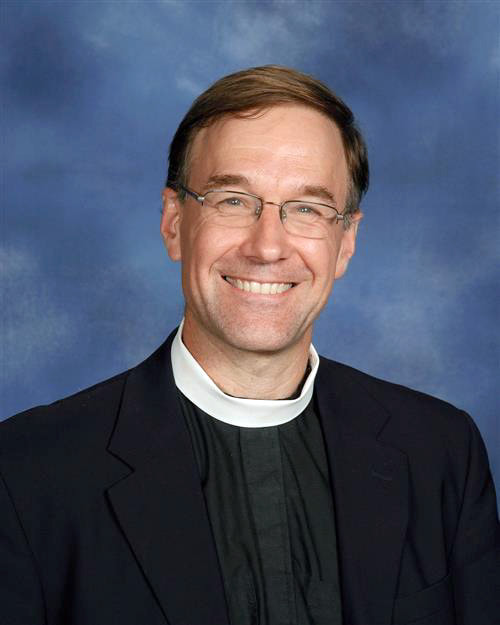|
That is another LONG Gospel reading! And another really rich one. We can’t go through the whole reading, so I’ll focus on Jesus’ exchange with Martha, the first sister to meet Jesus when he arrives at Bethany.
The problem, of course, is that Martha’s brother, and Jesus’ friend, Lazarus has died. But death is not the end of this story. Jesus’ first words to Martha are the promise that her brother will rise again. That promise of resurrection is the good news of our passage. And that promise, that good news, means even more than it seems. That promise, that good news, works at two different levels. Martha immediately gets one level of meaning. She understands Jesus to mean that Lazarus will rise in the general resurrection at the end of time, that Jesus is comforting her with the promise that she will one day be reunited with her beloved brother. That is real faith, and its substance is a big part of the Christian hope we share with Martha. When someone we love dies, it is a great consolation to know we will see that person again. As we face our own mortality, it is a great consolation to know that we, too, will live again, that at death, our life is changed, not ended. Jesus must surely have been pleased at Martha’s faith and her hope for eternal life. After all, that faith and hope was a big part of his preaching. But that faith and hope was not all that Jesus meant here. Jesus was not talking to Martha about the distant future, at least not only. Jesus meant more than that. Jesus was talking about what was happening right then, about what he was just about to do. Jesus tells Martha he is resurrection and life. And Jesus raises her brother from the dead. Resurrection happens right there and then. We need to pause here. What Lazarus experienced on that day was not the full resurrection Christ himself would undergo after his crucifixion. It was not the full resurrection Lazarus himself will undergo on the last day. Full resurrection is more than a temporary return to life, even a miraculous one after four days in the tomb. Full resurrection is to eternal life, to the fullness of God’s presence, never to die again. That is not what happens here. But Lazarus’ return to life was a resurrection of sorts. And it was a miraculous foretaste of the full resurrection still to come. In his conversation with Martha, Jesus teaches an important lesson: resurrection will indeed happen on the last day. And, in ways great and small, we can experience foretastes of resurrection in our lives right now. Mostly our foretastes of resurrection will not be as dramatic as Lazarus coming back from the dead. But I recently learned about one that strikes me as almost that dramatic. Unfortunately, you don’t get a foretaste of resurrection without some kind of death first. As anyone my age or older is likely to remember, the Chernobyl nuclear plant in what is now Ukraine had a terrible accident in 1986. The result was a nuclear death for everything in the area. The nearby city of Pripyat, population nearly fifty thousand, had to be evacuated immediately. Initially the inhabitants expected to return after a few days, but the evacuation zone was soon made permanent. Imagine what that must have been like for those poor people. They lost everything. Their city had died. A pine forest near the scene of the accident died, too. In an effort to reduce the danger from radioactivity, workers bulldozed the trees, then covered them with sand. The ground remains highly contaminated to this day. That was a lot of death, literal and metaphorical. But in the midst of all that death, new life emerged. A new forest sprang up where the old forest had been, and even in the old city. Animals moved in, including endangered species. Wikipedia calls it a “radiological reserve” and an “involuntary park.” The long-term impact on the flora and fauna is still not known, but the forest and its inhabitants seem to be flourishing, astonishingly so. I saw images of the forest and some of its animals on the nature program Our Earth, where the narrator gave it as a hopeful example of how resilient nature can be when we give it a chance. The forest around Chernobyl today is a foretaste of resurrection in our time, a sign of the way God brings new life even out of terrible death. That’s a big one. But as soon as you start looking, there are signs of resurrection all around us. The most obvious signs of resurrection right now are in nature. Several years ago, Carrie and I planted a bunch of crocuses around our property. As of this week, it looks like all died but one, and that one was pretty droopy when I spotted it. That was disappointing. But then I noticed a pair of impressive and beautiful patches of crocus hidden under one of our bushes. And I rejoiced in what is for me the first sign of spring. Crocuses represent resurrection and new life after a long winter. Later today, some of us are going on a Creation Walk to look for more signs of spring, more hints and glimpses of resurrection. I think, too, about relationships. When Carrie and I had been married about ten years, we went through a hard time. At points, I thought our marriage might be over. It was a Good Friday, crucifixion kind of time for us. But the Holy Spirit swirled around, and breathed new life into a dying relationship. Now we’ve passed thirty years and are still going strong. For me personally, that will surely be the most important taste of resurrection I experience until the last day. Resurrection happens in our individual lives, too, and it’s probably this arena that is most relevant to the season of Lent. Every time we sin, every time we turn away from God, every time we fail to love, we are rejecting true life and experiencing a little death. In Lent, not only but especially, we acknowledge our sins and our failures. We repent. And we hope that God will be merciful to us on the last day. But the good news of this passage, the good news of our faith, is that we don’t have to wait to receive God’s forgiveness, to have another chance to get it right, to be moved from the little death of sin into new life with God, to have a foretaste of full resurrection. The promise of God’s forgiveness, the promise that, with God’s help, we can put the past behind us and live into a better present and future, into lives more marked by love and joy, is a great gift. We can repent and truly turn to the Lord. That promise is for right now. That promise is something we can rely on in the midst of the swift and varied changes of the world and the trials and tribulations of our lives, even self-imposed trials and tribulations. As Christian people, we live in hope for the establishment of God’s kingdom and the resurrection to eternal life at the last day, just like Martha did. But no more than Martha should we postpone all of our hopes to a distant future. Christ is with us always. Resurrection and life are with us always. That is the good news. Our calling as Christian people is to hold on to that good news and to share it. May we be faithful to that calling. In Christ’s name. Amen.
0 Comments
|
Rector
Rev. Dr. Harvey Hill Third Order Franciscan Archives
July 2024
Categories |


 RSS Feed
RSS Feed
